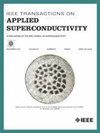Optimal Impedance Reshaping Approach for Inhibiting Subsynchronous Oscillation in Virtual Synchronous Generator Based on SMES-Battery
IF 1.7
3区 物理与天体物理
Q3 ENGINEERING, ELECTRICAL & ELECTRONIC
引用次数: 0
Abstract
Regarding a hybrid energy storage system (ESS) with superconducting magnetic energy storage (SMES) and battery, it can adopt the virtual synchronous generator (VSG) control to fulfill the grid-forming capability while doing more active voltage/frequency support. This article proposes an optimal impedance reshaping approach to inhibit the subsynchronous oscillation in the VSG based on the SMES-battery. Firstly, the theoretical modeling of the VSG as well as the SMES-battery is conducted. Then, the VSG's sequence impedance characteristic is investigated, and the subsynchronous oscillation influence is analyzed. By introducing an impedance reshaping link and revealing its effects on the VSG's low-frequency impedance, an optimized objective function with a minimum impedance phase difference is designed, and the improved particle swarm optimization is adopted for obtaining the solution. Using the MATLAB platform, a detailed simulation model is created, and different algorithms are considered to check the performance of the optimal impedance reshaping approach. Combining the time-domain simulation waveforms and frequency responses, the proposed method enables to effectively ameliorate the impedance features of the VSG, and inhibit the low-frequency oscillation while alleviating the power and current transients.抑制基于 SMES 电池的虚拟同步发电机次同步振荡的最佳阻抗重塑方法
关于带有超导磁能存储(SMES)和电池的混合储能系统(ESS),它可以采用虚拟同步发电机(VSG)控制来实现电网形成能力,同时提供更多主动电压/频率支持。本文提出了一种优化阻抗重塑方法,以抑制基于 SMES 电池的 VSG 中的次同步振荡。首先,对 VSG 以及 SMES 电池进行了理论建模。然后,研究了 VSG 的序列阻抗特性,并分析了次同步振荡的影响。通过引入阻抗重塑链路并揭示其对 VSG 低频阻抗的影响,设计了阻抗相位差最小的优化目标函数,并采用改进的粒子群优化方法求解。利用 MATLAB 平台创建了详细的仿真模型,并考虑了不同的算法来检验最优阻抗重塑方法的性能。结合时域仿真波形和频率响应,所提出的方法能有效改善 VSG 的阻抗特性,抑制低频振荡,同时缓解功率和电流瞬态。
本文章由计算机程序翻译,如有差异,请以英文原文为准。
求助全文
约1分钟内获得全文
求助全文
来源期刊

IEEE Transactions on Applied Superconductivity
工程技术-工程:电子与电气
CiteScore
3.50
自引率
33.30%
发文量
650
审稿时长
2.3 months
期刊介绍:
IEEE Transactions on Applied Superconductivity (TAS) contains articles on the applications of superconductivity and other relevant technology. Electronic applications include analog and digital circuits employing thin films and active devices such as Josephson junctions. Large scale applications include magnets for power applications such as motors and generators, for magnetic resonance, for accelerators, and cable applications such as power transmission.
 求助内容:
求助内容: 应助结果提醒方式:
应助结果提醒方式:


